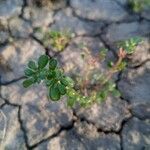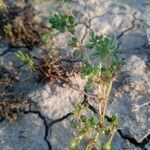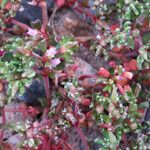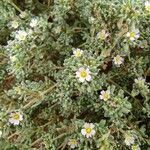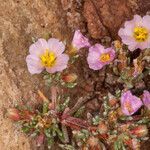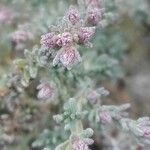Herbs annual. Stem prostrate, 6-16 cm, richly branched from base, sparsely white puberulous, hairs incurved. Petiole 1-2 mm; leaf blade narrowly obovate, obovate, or elliptic, sometimes orbicular on lower leaves, 2-7 × 1-2.5 mm, abaxially slightly powdery-puberulous, adaxially glabrous, base attenuate into a short petiole, apex obtuse or retuse. Flowers subtended by 4 leaflike floral bracts, borne in terminal or axillary dichasia, rarely solitary, with much of plant often composed of elongated compound dichasia in which branches often develop unequally. Calyx tube 2-3.5 × 1-1.5 mm, 5-ribbed; teeth 5, subulate, 0.5-1 mm. Petals 5, pink to violet, oblong-oblanceolate, oblong-obovate, or spatulate, 3-4(-5) × 0.7-1.4 mm, attenuate below middle, apex erose denticulate; ligule oblanceolate-elliptic. Stamens 6. Ovary with numerous ovules on 3 parietal placentas. Capsule oblong-ovoid, ca. 2 × 1 mm. Seeds numerous, golden brown, oblong-ellipsoid, 0.5-0.7 × ca. 0.3 mm, acute in lower part. Fl. and fr. May-Aug. 2n = 20.
Herbs, annual, often prostrate, to 1.5(–3) dm; branches glabrous or puberulous, hairs erect, usually curved, sometimes straight. Leaves: petiole 0.8–2 mm, markedly tapering toward blade, apex narrower than base of blade; blade gray-green, usually narrowly obovate or obovate to elliptic or oblong-elliptic, sometimes orbiculate, flat, 2–7 × 1–3 mm, margins slightly to loosely revolute, abaxial surface mostly exposed, adaxial surface usually glabrous, sometimes glabrate. Inflorescences usually compound, sometimes simple dichasia, sometimes solitary flowers. Flowers: calyx 2.5–4.5 mm, lobes 5, 0.5–1 mm; petals 5, pink to violet, oblong-oblanceolate to spatulate, 2.5–5.2 mm; stamens 6, included to ± exserted, 1.7–3.5 mm; anthers yellow; style included to ± exserted, 3-branched; ovary 3-carpellate; ovules 25–60, attached along sutures, funiculi erect. Seeds 20–60 per capsule, oblong-ellipsoid, 0.4–0.7 mm. 2n = 20.
Annual herb, 0.02-0.35 m high; internodes glabrous or puberulous with short, curly hair, branchlets contracted. Leaves ovate to oblanceolate, upper surface glabrous, punctate, lower glabrous to puberulous, margins recurved to revolute; petioles fused below with sheath. Flowers small, many, scattered and solitary, in forks of branches, flanked by side branches. Calyx tubular. Petals pink, mauve or white. Stamens exserted from corolla throat. Ovary ± 45 ovules; styles exserted above stamens. Flowering time all year. Fruit a capsule. Seeds 0.5 mm long, ovoid-fusiform, papillate, reticulate.
Annual, rarely perennial herb, 0.02-0.35 m high, with branches. Stems with internodes usually long, glabrous or puberulous with short curly hairs; branchlets usually contracted, forming leafy fascicles at nodes; branches spreading, often reddish. Leaves with short petioles fused below to stipular, amplexicaul, ciliate sheath; blade ovate to narrowly ovate, 3-5 mm long, flat or with margins recurved to tightly revolute. Flowers: many, solitary in forks of branches; petals ± 5 mm long, pink, mauve or white; Jan.-Dec.
Prostrate, annual herb; stems sparsely pubescent or glabrous. Leaves petiolate, linear-oblong to ovate, 2–4 mm long, mostly flat, glabrous above, densely white-puberulous below; petiole distinct, c. 1 mm long. Flowers in elongated dichasia; bracts and bracteoles similar to leaves. Calyx 3.5–4 mm long, c. 1 mm diam., glabrous outside or sides of ribs puberulous. Petals 5, 3.7–4.3 mm long. Stamens 5 or 6. Style 3-branched; stigma linear-clavate; ovules numerous; placentation parietal. Seeds papillose.
Spreading annual or perennial, up to 100 mm tall, often forming mats, with ± widely spaced clusters of leaves along stems. Leaves shortly petiolate, ovate, flat or revolute. Flowers numerous, small, solitary in branch forks, lilac.
Spreading annual or perennial. Leaves shortly petiolate, ovate, flat or revolute. Flowers numerous, solitary in branch forks, lilac.
A diffuse much-branched herb a few inches high, with opposite leaves, often covering the ground.
